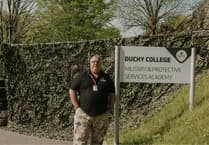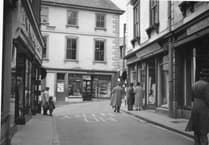The future of Callington's Old Clink building was raised as an urgent item at a Caradon council committee meeting this week.
It was discussed by the housing and property committee on August 2, and local councillors Kathy Pascoe and Tony Nettle had trouble suggesting an adequate solution to the listed building's future, as it is said to be collapsing.
Temporary scaffolding is currently holding up The Clink - but with two walls bulging outwards there are real risks of total collapse. The Caradon-owned grade two listed building was historically a local lock up and was subsequently used as a vestry under leasehold with the church. That arrangement expired in 1997, but at no time was the church responsible for the property's condition. Recently the two storey 380sq ft gaol has deteriorated markedly, and some urgent restoration measures are needed.
English Heritage has now become involved - and it is said the problem could be solved by installing a steel ring beam as a ceiling to which the external walls would be 'tied'. However, there are risks attached as the construction work would be a delicate exercise, and other problems could arise.
Estates officer, Brian Moriarty, said the minimal approach of a steel support could cost up to £60,000. He stressed the Old Clink, as a listed building, was the council's responsibility, and said currently the scaffolding is costing £200 per month. He had considered the subject in tandem with the council's engineers and English Nature.
Mr Moriarty put forward five ideas of action. He said to do nothing was not really an option as Caradon has a statutory obligation to keep the building in good repair. To carry out minimal repairs would cost £60,000 in stabilising the building without identifying any future use; while the third option would be to complete stabilising work plus refurbishment and an extension of the accommodation area before putting the building to a charitable/social use. This could cost more than £100,000, but have no 'best value' return on the outlay. As an alternative the same course could be followed, but with the restored unit put to commercial or residential use. As a fifth option the council could dispose of the property to an appropriate body interested in owning and preserving heritage buildings.
None of these ideas gained much enthusiasm and there was some regret that the building had not collapsed prior to the debate. Mrs Pascoe felt the fifth suggestion was unlikely, and she could not see a residential proposal was viable. There were doubts about the extent of the cost of stabilisation, and members felt grant aid must be fully investigated with the help of English Heritage. This is to include the council's legal liabilities in cases like this, and the penalties likely if the building is virtually left abandoned.
Mr Moriarty will report again at the next meeting of the committee.



